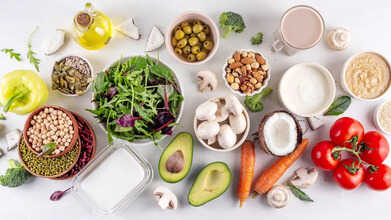- Health Conditions A-Z
- Health & Wellness
- Nutrition
- Fitness
- Health News
- Ayurveda
- Videos
- Medicine A-Z
- Parenting
World Osteoporosis Day: 5 Superfoods That Can Help Your Bone Health

World Osteoporosis Day is observed on October 20 to highlight the importance of early diagnoses of osteoporosis, awareness around it and how it can be treated or prevented.
What Is Osteoporosis?
It is a disease in which the bones become brittle due to a decrease in bone mineral density and bone mass. As per the International Osteoporosis Foundation, worldwide, 1 in 3 women and 1 in 5 men aged 50 years and over suffer from Osteoporotic fracture.
Osteoporosis causes bones to become so weak and fragile that they break easily by just a minor fall, a bump, a hard sneeze, or a sudden movement. These fractures could be life-threatening and a major cause of pain and long-term disability.
History
This day was established in 1996 by the National Osteoporosis Foundation, to raise awareness among the most vulnerable populations, including post-menopausal women. The day also addresses the care gap, as only 20% of patients with osteoporotic fractures are actually diagnosed or treated for osteoporosis. In 2010, in Europe, 12.3 million people were considered to be at a high risk for the same, were left untreated.
How Can You Maintain Bone Health?
- Regular Exercise, and weight training.
- With enough nutrition intake like calcium, vitamin D and protein.
- Maintaining a healthy lifestyle and avoiding sedentary lifestyle.
- Finding out about the risk factors and getting checked regularly.
- Getting tested for early diagnosis.
What Are The Top Five Superfoods For Bone Health?
- Green Vegetables, including Chinese cabbage, bok choy, kale, collard green, and turnip green. One cup of cooked turnip greens has 200 milligrams of calcium, which is 20% of the daily goal. The vitamin K in green vegetables also reduces the risk of osteoporosis.
- Food rich in magnesium and potassium also help with your bone health. Potassium neutralises acid in your body and can leach calcium out of your bones. Having a baked medium-sized potato can give you 31 milligrams of magnesium and 542 milligrams of potassium.
- You can add a grapefruit to your breakfast. Citrus fruits have vitamin C and it helps prevent bone loss.
- Fig is also a great source of calcium and other bone-health-related nutrients like potassium and magnesium.
- Fatty fish is also rich in vitamin D, calcium and omega-3 fatty acids that help with bone health.
Vegan Children Are Shorter And Skinnier Than Meat-Eaters, Nutritionists Raise Concern

Credits: Canva
Children following vegan and vegetarian diets may be missing key nutrients, according to a group of international researchers who shared their findings on Friday.
Plant-based eating has long been linked with lower risks of heart disease and stronger immunity. Yet a new peer-reviewed study, the largest of its kind, analysed 48,000 children and adolescents and found that vegetarian kids were consuming fewer calories, less protein and fat, and lower amounts of important nutrients like zinc and vitamin B12, which supports the nervous system. Vegan children showed similar patterns, with a particularly noticeable lack of calcium, which is vital for bone health.
Vegan Children Are Shorter And Skinnier Than Meat-Eaters
“Vitamin B12 rarely reaches adequate levels without supplementation or fortified foods, and calcium, iodine, and zinc are often at the lower end of recommended intake, making them critical nutrients for kids on plant-based diets,” said Dr. Jeannette Beasley, associate professor at New York University and one of the study’s authors.
The research reviewed 59 studies across 18 countries, comparing nutritional outcomes among 7,280 vegetarians, 1,289 vegans, and 40,059 children who ate both plants and meat (omnivores).
A Boost To Heart Health
While the study highlighted potential nutrient gaps in plant-based diets, it also showed benefits. Vegetarian children consumed more fibre, iron, folate, and vitamin C than omnivores, and both vegan and vegetarian children showed healthier hearts.
They had lower levels of LDL cholesterol, the “bad” cholesterol that can clog arteries and increase the risk of heart attacks and strokes later in life.
“The more animal products replace whole plant foods in the diet, the worse cardiovascular health tends to be,” said Dr. Dana Hunnes, senior dietitian at Ronald Reagan UCLA Medical Center, who was not involved in the study, as per The Independent.
Vegan and vegetarian children were also shorter and had a lower body mass index than meat-eaters, which may reduce the risk of obesity and diabetes—conditions that can further impact heart health.
Small Snacks, Big Difference
Although plant-based diets may leave gaps in nutrients like B12 or zinc, careful planning can help children meet their needs.
While animal products are naturally higher in zinc, lentils, pumpkin seeds, and cashews are excellent plant-based sources, with cashews providing nearly eight grams of zinc per cup. These can be eaten as snacks, added to soups, or blended into smoothies.
For vitamin B12, plant-based children can include seaweed or shiitake mushrooms in their diet. A 100-gram serving of shiitake mushrooms contains about 5.6 micrograms of B12.
According to Stanford Medicine, children should get between three and 11 milligrams of zinc depending on age, and between 0.9 and 2.4 micrograms of vitamin B12.
“Our findings suggest a balanced approach is key, with families ensuring kids get enough of vitamin B12, calcium, iodine, iron, and zinc to grow and thrive,” said Dr. Wolfgang Marx, co-author and senior research fellow at Deakin University in Australia.
Man Suffers Stroke After Heavy Energy Drink Use – Why Doctors Are Concerned?

Credits: Canva
A fit and otherwise healthy man in his fifties has been left without sensation on the entire left side of his body after suffering a stroke linked to his daily energy drink habit. Doctors were puzzled at first because his medical history was clear, yet his blood pressure was extremely high. It was only when he admitted to drinking about eight cans a day that they traced the cause of the clot in his brain.
The case has prompted specialists writing in the BMJ Case Reports journal to push for tighter oversight of energy drinks, which are consumed by more than 1.7 million people in the UK. Concerns about their safety have grown in recent years, especially since some contain more caffeine than several shots of espresso.
Energy Drink Warning After Man Suffers Stroke Due To Excessive Consumption
Reaching for an energy drink may feel like a quick solution when fatigue sets in, but with rising questions about their health impact, experts are asking people to be careful. A December 2025 case report in BMJ Case Reports described how heavy use of energy drinks may raise the risk of heart disease and stroke.
The man in his fifties arrived at the hospital with extremely high blood pressure. He had weakness on the left side of his body, numbness and trouble with balance, walking, swallowing and speech. Tests confirmed a stroke. His blood pressure dropped with treatment, but once he returned home, it rose again despite being on medication.
Further questioning showed he had been drinking roughly eight energy drinks every day. Each one contained around 160 milligrams of caffeine, far above the recommended daily amount. When he stopped drinking them, his blood pressure settled and he no longer needed medication.
How Are Energy Drinks Bad For Your Heart?
Many energy drinks have high levels of caffeine and sugar, both of which can raise health concerns.
“Too much caffeine can disrupt sleep, worsen insomnia and add to mental health strain,” Dr. Frank Hu, a professor of nutrition and epidemiology at Harvard Medicine School of Public Health, told TODAY.com.
The FDA advises that up to 400 milligrams of caffeine a day is safe for most adults. A single energy drink can reach or exceed that range, Hu said. A small energy shot can contain around 230 milligrams of caffeine, an 8.4-ounce drink can have about 80 milligrams and a 20-ounce can may reach 190 milligrams. People react to caffeine differently, the FDA notes.
Katherine Zeratsky, a registered dietitian nutritionist at Mayo Clinic, said that caffeine on its own may be safe for many, but when it is combined with other stimulants commonly found in energy drinks, the total effect may be too strong for the heart and blood vessels.
“The idea is that caffeine mixed with other ingredients creates a stronger stimulant response that affects heart rate, heart rhythm or blood pressure,” Zeratsky told TODAY.com. “That is what can send someone to the emergency department with a cardiac issue.”
Along with caffeine, Hu and Julia Zumpano, a registered dietitian at the Cleveland Clinic’s Center for Human Nutrition, pointed out another problem in many energy drinks: large amounts of sugar.
“Excess sugar contributes to weight gain, obesity and Type 2 diabetes. Because these drinks offer calories without nutrients, it is very easy to take in more than you realise,” Hu said.
Zumpano noted that this sugar load is especially risky for people with diabetes, obesity, heart disease or high triglycerides, which increase the chance of heart attack and stroke. “These drinks can also play a part in developing those conditions,” she said.
Look At Ingredient Labels Before Consuming Energy Drink
If you need an energy boost, the experts encouraged choosing options that are healthier than energy drinks. But if you still decide to buy one, they suggested checking the label closely. Try to avoid caffeine and sugar levels that exceed daily recommendations and stay cautious of long ingredient lists.
Energy drinks often contain caffeine, sugar, added vitamins and amino acids. Common ingredients include ginseng, guarana, L-carnitine and taurine. Zumpano explained that while these may be considered safe on their own, their combined effect is not well understood.
“Some of these ingredients are familiar, and for others we do not have enough strong research, so they are not recommended if you plan to drink them often,” she said. She advised avoiding drinks with ingredients you do not recognise and choosing those with simpler formulations.
Can Eggs Cause Cancer? Nitrofuran Traces Found In Egg Samples Raise Safety Concerns

Credits: Canva
Eggoz, a premium egg-selling company landed in a controversy after a YouTube video went viral claiming that their sample had tested positive for Nitrofuran. This chemical is a broad-spectrum antibiotic, but is banned due to concerns about potential carcinogenicity and persistent residues. Studies have also shows that nitrofuran and its metabolites could cause cancer.
How Did This Brand Land In Cancer Controversy?
Trustified, a brand that provides laboratory testing shared a video that claimed to have found genotoxic substances in eggs produced by Eggoz Nutrition. This led to questions which were raised on the nutritional value of the eggs sold by the brand.
Arpit Mangal, who runs the social media channel, said that lab tests on eggs sold under the Eggoz brand showed the presence of AOZ, a marker that can signal past exposure to nitrofuran antibiotics during poultry production. He also shared an Instagram reel titled “Real Egg vs ‘Plastic Egg’ Claims – Lab Test Teaser,” telling viewers, “When was the last time you questioned the quality of your eggs? We took a deep dive into Eggoz, a brand everyone knows, and ran a test that’s never been done before. The results left us shocked.”
What Are The Doctors Saying?
Dr Sudhir Kumar, senior consultant Neurologist, Apollo Hospital told Times Now, "As of now, we do not need to get concerned, because it is well within the permissible limits, as with this much minute amount, there is no risk of cancer."
Experts say that while AOZ traces could be alarming, one needs to interpret the findings for scientific clarity.
"Eggs definitely have lots of benefits; they are a good source of protein and have vitamins, including B12. So, as of now, people should consume, but just that they should make sure that, yes, they are from a trusted source, and there should definitely be awareness that even good brands can have chemicals,” he added.
What Exactly Is AOZ?
AOZ, or 3-amino-2-oxazolidinone, is a metabolite linked to nitrofurans, a class of antibiotics that should not be used in poultry because of their potential to cause cellular and DNA-related damage when consumed in large or long-term doses. Experts clarify that finding trace amounts of AOZ in an isolated sample does not mean eggs are cancer-causing or unsafe for the public. Instead, its presence signals that the parent drug may have been used at some point.
Specialists explain that AOZ binds tightly to animal tissues and can linger long after the original antibiotic has broken down. This is why regulators consider AOZ a red-flag marker indicating previous exposure to nitrofurans rather than a direct toxin in itself.
Scientific studies have linked nitrofurans and their breakdown products to possible carcinogenic and mutagenic effects in animals. These concerns prompted many countries to introduce strict bans on their use in food-producing animals, including poultry, pigs, shrimp, and aquaculture.
Why Nitrofurans Are Banned
Nitrofurans were once popular in farming because they were inexpensive and worked effectively against a wide range of infections. However, they quickly convert into metabolites such as AOZ, AMOZ, AHD, and SEM, which become bound to tissues and can remain detectable for weeks. This persistence makes it difficult for authorities to monitor and prevent illegal use, and it raises concerns about potential long-term health risks for consumers.
Today, regulators in the European Union and several other regions use highly sensitive laboratory tests designed to detect these metabolites directly in products like meat, eggs, honey, and seafood. These tests help identify residues even when the original drug has vanished, ensuring greater oversight and food safety.
© 2024 Bennett, Coleman & Company Limited

